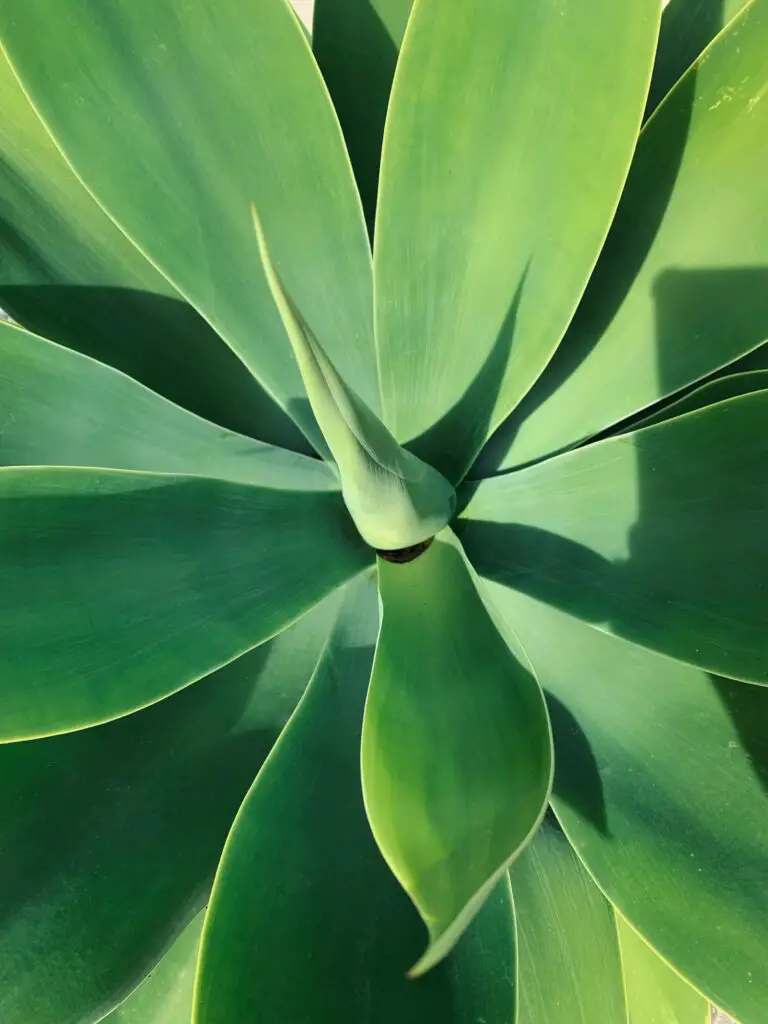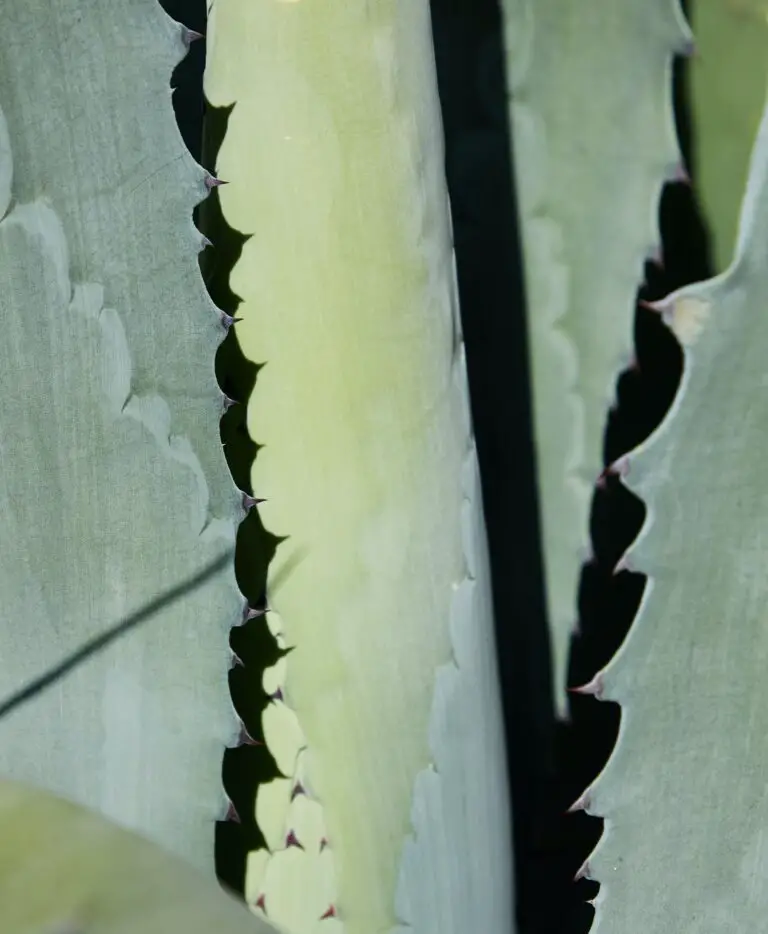Introducing Agave Attenuata
Speak of elegance in the world of botanicals, and the Agave Attenuata shines brightly. Lovingly known as the ‘Foxtail Agave’, its alluring spiral scape shooting up to heights that could reach ten feet sets it apart in the plant universe.
Imagine a garden complemented with the architectural astuteness that the Agave Attenuata offers. Its wide rosette and impressive curve making a beautiful gradient from the centre to the tips – resembling, yes, a fox’s tail. Endowed with a soft shade of green and gracefully wide leaves, this particular agave species is more than an ordinary desert plant.
From a practical perspective, the Agave Attenuata stands out for its non-aggressiveness. Unlike its cousins who are popular for their lethal spikes, the ‘Swan’s Neck,’ another nickname owing to its unique formation, poses no such harmful threats. This feature is especially useful for families with playful children or pets.
To get to another exciting part, have you ever asked yourself why this Agave variant carries the name ‘Attenuata’? The answer lies in its Latin roots, where ‘Attenuata’ means ‘tapering’. And tapering it does! Watch the majestic rosette spiral exquisitely into a thin, tapering inflorescence, and you will start admiring the beauty and symmetry nature offers.
So, whether you’re a home gardener looking to add an exotic touch to your garden, or an enthusiast drawn to botanical wonders, Agave Attenuata is undeniably a spectacle to hold and behold!
Origins and Habitat of Agave Attenuata
Let’s take a step back in time and explore the birthplace and native habitat of the eye-catching Agave attenuata, also known as the Foxtail Agave. If there’s one thing this species loves, it’s a sunny nook in its homeland.
Originally hailing from the vibrant landscapes of central Mexico, Agave attenuata found its original footing in the mountainous regions of Jalisco, Michoacán, and Mexico State. The subtropical environment of favorable temperatures, rocky terrain, and specific soil conditions define the font of its origin.
Unlike some of its agave kin, this Foxtail counterpart isn’t a fan of extreme desert dryness or harsh cold. Place one in ample sunlight, and you’ll pretty much have a content plant. That being said, they can tolerate shade to a degree and can survive in cooler conditions, as long as they’re not overly exposed to frost.
This species thrives in well-draining soil (and loathes water-logged feet!). With their native terrain being rocky and mountainous, they are no strangers to rocky and sandy soils. In fact, these are ideal as they mimic the Foxtail’s natural habitat.
Wondering what this means for your own foxy plant at home? Well, the good news for gardeners and plant enthusiasts is that the Agave attenuata is a fairly adaptable species. It seems to be quite content in a range of environments – from coastal locations to inner-city balconies, provided they get their dose of sunshine and aren’t swamped with water. So go ahead, bring a piece of central Mexico into your home.
For more information on the history and cultivation of Agave attenuata, here’s a resource that dives deeper into this succulent species.
In the end, understanding the origins and ideal habitat conditions of the Agave attenuata is instrumental in successfully cultivating this plant and ensuring its health and longevity. Whether you desire to create a small piece of central Mexico in your backyard or house this spectacular species indoors, it’s all about replicating those native conditions as closely as possible. Voila, a happy Foxtail Agave!
Growing and Caring for Agave Attenuata
Considered the most attractive of the Agave family, the Agave Attenuata, also known as the Foxtail or Lion’s tail, stands out for its dramatic yet elegant appearance. Named for their arching, drooping inflorescences that emerge as a byproduct of the plant’s maturity, they are a sight to behold with their impressive rosettes of large, grayish-blue leaves. But how do you care for an Agave Attenuata to keep it thriving?
Soil Type
Like many succulent types, Agave Attenuata prefers a well-draining soil mix. A cactus or succulent potting mix would be ideal. Often, adding some coarse grit to the mix can promote better drainage—an essential aspect considering Agave Attenuata’s low tolerance for waterlogging.

Light Exposure
When it comes to light exposure, Agave Attenuata enjoys full sun to light shade. Having said that, if you live in an area with intense summer heat, some afternoon shade would be beneficial. This is particularly crucial for potted specimens, which can be moved around according to the sun’s intensity.
Watering and Temperature Requirements
As a drought-tolerant plant, Agave Attenuata does not require constant watering. In fact, it’s much safer to under-water than over-water this plant. Think “dry and cool” for winters and “hot and a little wet” for summers.
Agave Attenuata is surprisingly frost-tolerant, withstanding temperatures as low as 28°F. However, prolonged cold may result in damage to the active growing tips, leading to a pause in growth and potential rotting.
Example scenario for growing Agave Attenuata
Imagine, if you will, a quaint garden situated in Southern California. The soil is well-draining, the summers abundant with sunlit days, and the winters mildly frosty. With minimal effort, ideal climatic conditions, and the right love and attention, the Agave Attenuata will thrive in such an environment, presenting you with its beautiful foxtail-like inflorescence in due time.
Remember, patience is key with Agave Attenuata. While it may take time to see this plant flourish, the sight of the beautiful, mature rosettes is undoubtedly a reward worth waiting for.
Below is an image of an Agave Attenuata, in its full glory, standing tall with a beautiful arching inflorescence. Truly a testament to the exotic beauty of succulents.
Propagation Techniques for Agave Attenuata
Ever marveled at the soft curves and striking appearance of the Agave Attenuata and thought about propagating one yourself? You’re in luck! In this section, we delve into the process of propagating this beautiful plant expeditiously and effectively. So, sit back, get your gardening gloves ready, and let’s get started.
The journey of propagating an Agave Attenuata involves a series of steps, all of which are integral to ensure the healthy growth of your plant.
Step 1: Selection of the Mother Plant
The first step involves identifying a healthy Agave Attenuata to become the ‘mother plant’. This selection is crucial as the health and vitality of the mother plant directly influence the success of propagation. So scout for a parent plant with no signs of pest infestation or disease. It should ideally have ample mature leaves and be in its prime growth phase.
Step 2: Removal of Offsets
The second step is focused on finding and removing offsets or ‘pups’ from the mother plant. The offsets are small plantlets that grow from the base of the mother plant and are exact genetic replicas. Use a clean and sharp knife to cut the pup away from the main plant. Do this gently to avoid injuring the mother plant.
Step 3: Preparing for Propagation
Once you have successfully removed an offset, it’s time to prepare it for propagation. Let the offset dry out for a couple of days till a callous forms over the cut surface. This helps to protect the young plant from potential fungal infections.
Step 4: Planting the Offsets
Now, it’s time for the most exciting step – planting the offset! Make sure to choose a well-draining soil mix and water it thoroughly. Afterward, plant the offset into the soil, ensuring that it stands upright. The soil should cover the roots adequately.
Step 5: Caring for the New Plant
Once your offset is comfortably settled in its new home, you must take care of it diligently. New plants are best kept in partial shade and must not be overwatered.
Even though it might seem intimidating at first, the propagation of Agave Attenuata can be a very rewarding process. Starting off might require some patience and dedication, but the payoff is worth every second, especially when you see your tiny offset grown into a beautiful Foxtail Agave.
For more in-depth information about the propagation of Agave Attenuata, you can check out this fantastic guide provided on Succulent Alley.
Potential Problems and Solutions in Agave Attenuata Cultivation
When it comes to the cultivation of the Agave attenuata, also known as the Foxtail Agave, there’s no denying that it’s generally an easy-going and low-maintenance type of plant. Nonetheless, like any other species, it has its share of potential issues. Knowing what these possible setbacks are and how to deal with them can make your Foxtail Agave cultivation journey more successful.
Pests and Their Prevention

Interestingly, the Agave attenuata serves as a gastronomic delight to some pests. You might notice the occasional nibbles from critters such as snails, or the grubs of the Agave Snout Weevil, which often infest and can cause the imminent demise of the plants if left unattended.
But don’t panic! Integrated Pest Management strategies such as the use of predatory insects for biological control, or organic pesticides can be implemented. Physical removal of pests can also effectively mitigate the situation. But remember, an ounce of prevention is worth a pound of cure. Keep the surroundings of your plants clear of debris where pests could potentially breed.
Diseases and Their Solutions
Although tough, our beloved Foxtail is also prone to fungal diseases, especially in an overly humid environment. If your Agave attenuata gets yellow and wilted leaves or shows signs of rot, chances are, they’re suffering from a fungal invasion.
Worry not! Fungicides can come to your plants’ rescue. Furthermore, ensuring that your plants are in well-drained soil and are not over-watered can largely prevent this issue. Remember, more plants have died from overwatering than underwatering.
Environmental Stressors and How to Deal with Them
Agave attenuata is a lover of warm climates and does not appreciate temperatures below 25 degrees F. In the case of unexpected frosts, the leaves may sustain damage, appearing limp and discolored afterwards.
If your area is naturally frost-prone, you might want to consider pot cultivation. By doing so, you can move your plants to a more protected location during those frosty months. Else, providing cover during cold nights can also significantly reduce damage.
Due to unforeseen circumstances, we were unable to provide a video for this section. However, a quick search for “Agave attenuata cultivation” on video platforms like YouTube will provide a wealth of visual guides and walkthroughs.
As we journey through the cultivation of the stunning Foxtail Agave, we’re bound to encounter a hurdle or two. But with knowledge on your side, you’re more than equipped to deal with anything that comes your way. Happy gardening!
Agave Attenuata in Landscape Design
Imagine you’re strolling through your garden on a bright sunny day, the chirping of birds serenading your ears. As you take in the landscape around you, there’s one particular plant that completely captures your attention – standing proud and taller than the rest, it’s the stunning Agave Attenuata or Foxtail Agave.
Much like its name suggests, the Foxtail Agave is certainly no shy wallflower in any design setup. Its unique shape, featuring a curved stem adorned with a tight rosette of broad, pale green leaves gracefully sweeping back downwards, mimics the flowing tail of a fox. The Foxtail Agave’s form offers not just an interesting visual but also an excellent textural contrast in garden plot or pot.
One legendary feature that sets Agave Attenuata apart from its peers is its fantastic bloom. Roughly every ten years, this plant grows an impressive, towering floral stem up to 10 feet tall, bearing greenish-yellow flowers. Amazingly, unlike many plants, this dramatic spectacle won’t cost you the parent plant. After this, it can keep on living and continue to add unrivalled aesthetic appeal to your garden.
Perfect for cottage gardens, coastal landscapes, and even minimalist aesthetics, the Foxtail Agave is one flexible plant. For example, think of a coastal landscape. It can effortlessly blend with other drought-tolerant plants, such as lantanas and salvia, creating a balanced and lush palette. Alternatively, place it in a large decorative pot as part of a modern, minimalist balcony or patio design, allowing its architectural beauty to shine.
Another notable quality of the Agave Attenuata is its low maintenance requirements. Unlike most succulents, it is shade-loving and prefers indirect sunlight, well-drained soil, and only rare watering sessions to thrive. Fortunately, its minimalistic care routine doesn’t equate to minimal impact. Instead, it contributes to creating a serene look, both calming and utterly striking.
As someone smart said, “the beauty of nature will always make us feel small and appraise the beauty around us.” The Agave Attenuata in landscaping holds true to this word. It exudes a presence that isn’t there for a quick glance. It’s there for a long, captivating stare that makes you adore the plant world a tad bit more each time.
Frequently Asked Questions About Agave Attenuata
You’ve probably spotted the gorgeous Agave Attenuata more than a few times and marveled at it. With its sans-thorns appeal and curved stem, it’s hard not to be intrigued. So let’s answer some common questions about this unique plant, shall we?
How Long Does Agave Attenuata Live?
Longevity is a rather impressive trait of the Agave Attenuata. This plant has a life expectancy of about 10 to 15 years, longer than many of its succulent counterparts. Still, this all comes down to the environment it’s placed in and the care it receives. Just like humans, plants thrive in love and attention too!
Is Agave Attenuata Toxic?
If you’re a pet owner, this might be one of your top questions. Is the Agave Attenuata toxic? Breathe easy! Although some Agave plants have toxic sap, Agave Attenuata is considered non-toxic. However, it’s always a good idea to keep an eye on our furry friends as certain plants can cause irritation or allergic reactions to more sensitive individuals.
Does Agave Attenuata Need Pruning?
Pruning isn’t really a concern when it comes to Agave Attenuata. Unlike the rose bush in your garden that needs careful, seasonal pruning, this foxtail agave is quite low-maintenance. Just make sure it’s not outgrowing its pot or invading other plant areas, and you’re good.
Our discussion wouldn’t be complete without delving a little into the practical aspects of caring for this exotic plant. Here’s a helpful video to give you some great pointers.
Here’s hoping these questions and answers have provided a better understanding of the captivating Agave Attenuata. Just remember—plants don’t ask for much in return, just a little extra love and care.

